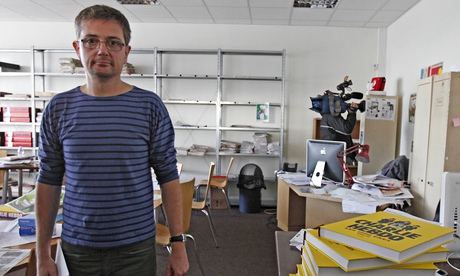......2名蒙面槍手闖入位於巴黎市區的總社,以AK-47突擊步槍與火箭筒(RPG)大開殺戒,
至少造成12人遇害、4人重傷,死者之中有2人是警察。
這是法國20年來最嚴重的恐怖攻擊事件。
至少造成12人遇害、4人重傷,死者之中有2人是警察。
這是法國20年來最嚴重的恐怖攻擊事件。
位於巴黎的《查理週刊》(Charlie Hebdo Officiel)辦公室今天稍早遭到歹徒持槍攻擊造成 12 人死亡、數人受傷的慘劇。《查理週刊》以反諷漫畫聞名,曾面臨侮辱伊斯蘭教的爭議。國際特赦組織法國分會Amnesty International France 秘書長 Stephan Oberreit 說:「對於言論自由與活躍的新聞文化而言,這無疑是黑暗的一天,更是令人震驚的人間悲劇。」
位於巴黎的《查理週刊》(Charlie Hebdo Officiel)辦公室今天稍早遭到歹徒持槍攻擊造成 12 人死亡、數人受傷的慘劇。《查理週刊》以反諷漫畫聞名,曾面臨侮辱伊斯蘭教的爭議。國際特赦組織法國分會Amnesty International France 秘書長 Stephan Oberreit 說:「對於言論自由與活躍的新聞文化而言,這無疑是黑暗的一天,更是令人震驚的人間悲劇。」
Fight intimidation with controversy: Charlie Hebdo’s response to critics
French magazine has history of defying attempts to curtail freedom of expression; the latest a provocative tweet to Isis chief
Live blog: follow the latest on Paris shootings
Live blog: follow the latest on Paris shootings

Moments before Charlie Hebdo’s offices were attacked, the magazine’s Twitter handle published a cartoon wishing a happy new year “and particularly good health” to Abu Bakr al-Baghdadi, the leader of Islamic State (Isis).
Its cover this week features Michel Houellebecq’s provocative new novel, Submission, which satirises France under a Muslim president. These are just the latest examples of a publication that responds to efforts at intimidation by being even more irreverent or outrageous, defying the constraints of religious sensitivity or political correctness.
In November 2011, the magazine’s offices were fire-bombed after it published a special edition, supposedly guest-edited by the prophet Muhammad and temporarily renamed “Charia Hebdo”. The cover was a cartoon of Muhammad threatening the readers with “a hundred lashes if you don’t die laughing”.
The petrol bomb attack completely destroyed the Paris offices, the magazine’s website was hacked and staff were subjected to death threats. But that did not deter the magazine, whose editor, Stéphane Charbonnier, has received death threats and lives under police protection.
Six days later, the magazine published a front page depicting a male Charlie Hebdo cartoonist passionately kissing a bearded Muslim man in front of the charred aftermath of the bombing. The headline was: L’Amour plus fort que la haine (Love is stronger than hate).
Less than a year later, the magazine published more cartoons of Muhammad, including images of him naked and a cover showing him being pushed along in a wheelchair by an Orthodox Jew. The French government had appealed to the editors not to go ahead with publication, and shut down embassies, cultural centres and schools in 20 countries out of fear of reprisals when they went ahead anyway.
Riot police were also deployed to the Charlie Hebdo offices to protect it from direct attacks. The foreign minister, Laurent Fabius, publicly criticised the magazine’s actions, asking: “Is it really sensible or intelligent to pour fuel on the fire?”
Gérard Biard, the editor-in-chief, rejected the criticism. “We’re a newspaper that respects French law,” he said “Now, if there’s a law that is different in Kabul or Riyadh, we’re not going to bother ourselves with respecting it.”
The attacks on Charlie Hebdo for its depiction of Muhammad and its consistently defiant response has put the focus on its attitude to Islam in particular, but the magazine’s earlier history reflects a readiness to offend all religions and challenge all taboos.
In 1970, its precursor, Hara-Kiri Hebdo, was banned for publishing a spoof of the reverent French coverage of the death of the former president Charles de Gaulle. To sidestep the ban, the editors renamed the magazine, choosing Charlie Hebdo because there was a monthly comic book in existence called Charlie Mensuel (named in turn after Charlie Brown) and as an irreverent reference to the recently deceased father of the French fifth republic.
The magazine folded in 1981 because of a lack of sales but relaunched in 1992 in its present form.
